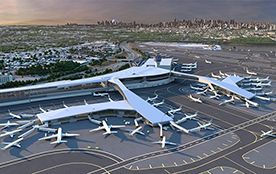LaGuardia, Newark Liberty airport redevelopment projects must meet LEED standards to support Port Authority energy goals


The redevelopment of LaGuardia’s Terminal B must meet LEED standards and
The Port Authority has implemented a broad range of energy-efficiency programs contributing to more than $9 million in annual savings and a 25,000-ton reduction in greenhouse gas emissions – the equivalent of taking 5,300 cars off the road.
The PA’s comprehensive sustainability and energy-saving programs include air quality initiatives and equipment and lighting upgrades across many of the agency’s key facilities, notably Port Authority buildings and facilities at the World Trade Center (WTC), the three major regional airports and the Lincoln and Holland tunnels.
“We know that sustainability efforts decrease operational costs and improve the quality of life around our facilities,” said Christine Weydig, the Port Authority’s Director of the Office of Environmental and Energy Programs (OEEP). “We intend to continue to promote sustainable, resilient design and operational improvements across all of our facilities.”
Three major airport redevelopment projects either under way or set to begin soon – Terminals B and C at LaGuardia Airport, and Terminal A at Newark Liberty International Airport — will be required to meet stringent Leadership in Energy and Environmental Design (LEED) standards upon completion, along with an increase in the use of electric ground service equipment and advanced systems to collect aircraft deicing fluid.
At the World Trade Center site, a number of conservation measures to achieve LEED certification have been established. The buildings feature daylight controls, occupancy sensors and low flush and flow rate fixtures, resulting in a 16-percent lighting power reduction and 20-percent reduced water usage.
Throughout the WTC site, the Port Authority strives for net-zero carbon emissions for electricity consumption through commercially purchased wind certificates. Each building is equipped to reuse storm water for cooling and irrigation purposes, and the World Trade Center Transportation Hub uses recycled rainwater for flush fixtures.
In addition, WTC has advanced energy- and water-saving technologies that use low-energy equipment, such as variable-speed fans and pumps, low-emission glass coating that reflects long-wave infrared energy, and a high-tech building management system that optimizes energy use and indoor air quality. In September 2016, One World Trade Center was awarded a LEED Gold certification by the U.S. Green Building Council for its green building design, construction, operations and maintenance solutions.
Liberty Park, which the Port Authority opened in 2016, features a multi-hued “living wall” that is 25 feet high and 336 feet long. The rooftop park hosts more than 1,000 evergreen shrubs, perennials and trees – including a descendant of Anne Frank’s famous Horse Chestnut Tree. Liberty Park received the 2016 Civic Betterment Award from the Building Owners and Managers Association International.
The Port Authority also is continuing to redevelop many of its other facilities to become eco-friendly, including the Brooklyn Cruise Terminal (BCT). BCT is the first Shore Power System (SPS) in the East that has been fully operational since November 2016. SPS cuts ports pollution by allowing ships to turn off diesel engines and connect to the local electrical grid to power all onboard services, including lighting, HVAC and elevators/escalators.
The project has reduced significantly the amount of fuel used by idling cruise ships, with a reduction of 1,500 tons of greenhouse gas emissions, 95 tons of nitrogen oxide, 93 tons of sulfur dioxide and 6.5 tons of particulate matter. Financial incentives have been put in place for ships, trucks and cargo equipment owners and operators to update and replace older, less efficient engines. Installation of the SPS installation was a product of Port Authority cooperation with the Red Hook community in Brooklyn.
Click for additional information on OEEP initiatives.
